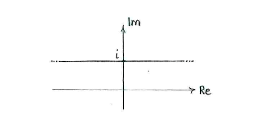Lösung 3.2:2e
Aus Online Mathematik Brückenkurs 2
(Unterschied zwischen Versionen)
K (Lösning 3.2:2e moved to Solution 3.2:2e: Robot: moved page) |
|||
| Zeile 1: | Zeile 1: | ||
{{NAVCONTENT_START}} | {{NAVCONTENT_START}} | ||
| - | < | + | Because the expression contains both <math>z</math> and <math>\bar{z}</math>, we write out <math>z=x+iy</math>, where <math>x</math> is the real part of <math>z</math> and <math>y</math> is the imaginary part. Thus, we have |
| - | { | + | |
| + | <math>\mathrm{Re}z=x</math> | ||
| + | |||
| + | <math>i+\bar{z}=i+(x-iy)=x+(1-y)i</math> | ||
| + | |||
| + | and the condition becomes | ||
| + | |||
| + | <math>x=x+(1-y)i \iff 0=(1-y)i</math> | ||
| + | |||
| + | which means that <math>y=1</math>. | ||
| + | |||
| + | The set therefore consists of all complex numbers with imaginary part <math>1</math>. | ||
[[Image:3_2_2_e.gif|center]] | [[Image:3_2_2_e.gif|center]] | ||
| + | |||
| + | {{NAVCONTENT_STOP}} | ||
Version vom 10:58, 3. Okt. 2008
Because the expression contains both \displaystyle z and \displaystyle \bar{z}, we write out \displaystyle z=x+iy, where \displaystyle x is the real part of \displaystyle z and \displaystyle y is the imaginary part. Thus, we have
\displaystyle \mathrm{Re}z=x
\displaystyle i+\bar{z}=i+(x-iy)=x+(1-y)i
and the condition becomes
\displaystyle x=x+(1-y)i \iff 0=(1-y)i
which means that \displaystyle y=1.
The set therefore consists of all complex numbers with imaginary part \displaystyle 1.

